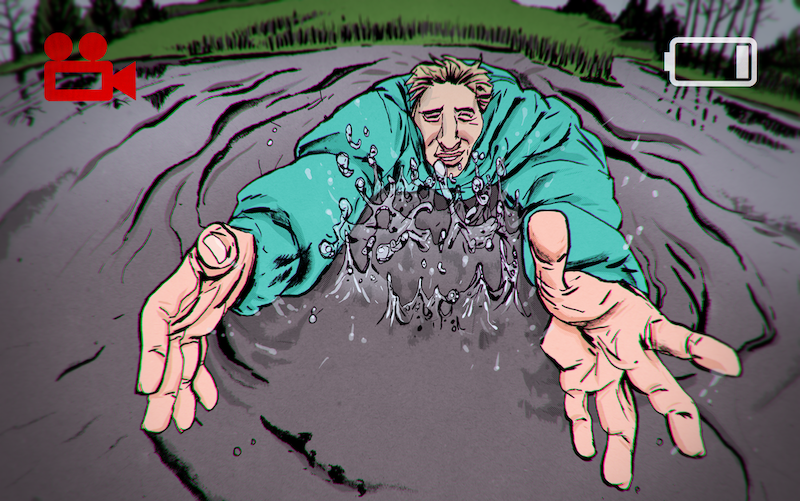Here is a story from my book Videotelling: YouTube Stories for the Classroom. It works well with face-to-face and live online video classes.
Part one: the image
This story is about a young Dutch man called Zwier. You can use the image above to introduce him to your students. Ask them to guess what’s going on – what’s the story?
Part two: story items
The story involves the following:
- a DJI Phantom (see below)
- a cold day in December
- an automatic landing
- a canal filled with ice-cold water
- a desperate man
Give these story items to your students. Invite them to ask you closed questions in an attempt to work out happens in the story. This will allow them to clarify the meaning of any unknown language and start to construct a narrative.
Note: The DJI Phantom is a popular make of drone. Show your students an image and find out if there are any drone enthusiasts in the class.

Part three: the story
Read the following story to your students. Speak slowly and clearly, make use of space, and don’t be scared to repeat the text, or parts of it, multiple times.
Have you ever wondered what would happen if you were flying a drone and the battery died?
Well, like many models, the Phantom series has a safety feature. Just before the battery dies, the drone will make an automatic landing. A Global Positioning System (GPS) inside the machine will guide it back to the same spot where it took off from. Clever, eh? What could possibly go wrong?
It’s a cold day in December. A young Dutch man called Zwier goes out with a group of friends to test his new DJI Phantom. He places it in the middle of a quiet road. It takes off and Zwier flies it above the houses, the trees, the roads, and the canals.
But after about fifteen minutes, the battery starts to die. The drone begins its automatic landing. But instead of landing on the road, the drone slowly starts to come down above a canal.
Zwier didn’t set the GPS correctly!
The canal is wide and deep. The drone is going to land right in the middle of it. Zwier has no choice. He runs to the canal and jumps in. The ice-cold water comes up to his waist.
Zwier moves to the centre of the canal as quickly as he can. He is desperate to catch the drone before it lands in the water. The water gets deeper and deeper as he goes: up to his chest, up to his neck, and then up to his chin.
The drone is just centimetres from the surface. With all his effort, Zwier throws himself forward and reaches out his arms.
So does Zwier manage to save his drone before it lands in the water?
Part four: the video
The great thing about this story is that it was all caught on camera. Ask students if they can guess who filmed it. The answer is the drone itself.
Have a class vote. Find out who wants Zwier to save his drone and who wants him to fail. You can use this an opportunity to introduce students to the concept of schadenfreude – the human experience of taking pleasure in other people’s failure.
Then show students the video.
Part five: back to the text
I always suggest revisiting a videotelling text after viewing the video. Give out copies to your students. They will will see the text in a new way. Language which was problematic before may now be clarified. Meaning has emerged.
Ask students to underline 8 language items in the text that they want to take away with them (words, structures, collocations, idioms, etc.)
Later, you can ask students to reconstruct the text and incorporate their selected language items into the story as they do so.
Videotelling: YouTube Stories for the Classroom
Drone disaster is one of 45 stories from my book Videotelling: YouTube Stories for the Classroom.
By the way, I once tried to get in touch with Zwier but I don’t think he got my emails. If anyone knows him, please say hello from Jamie!





